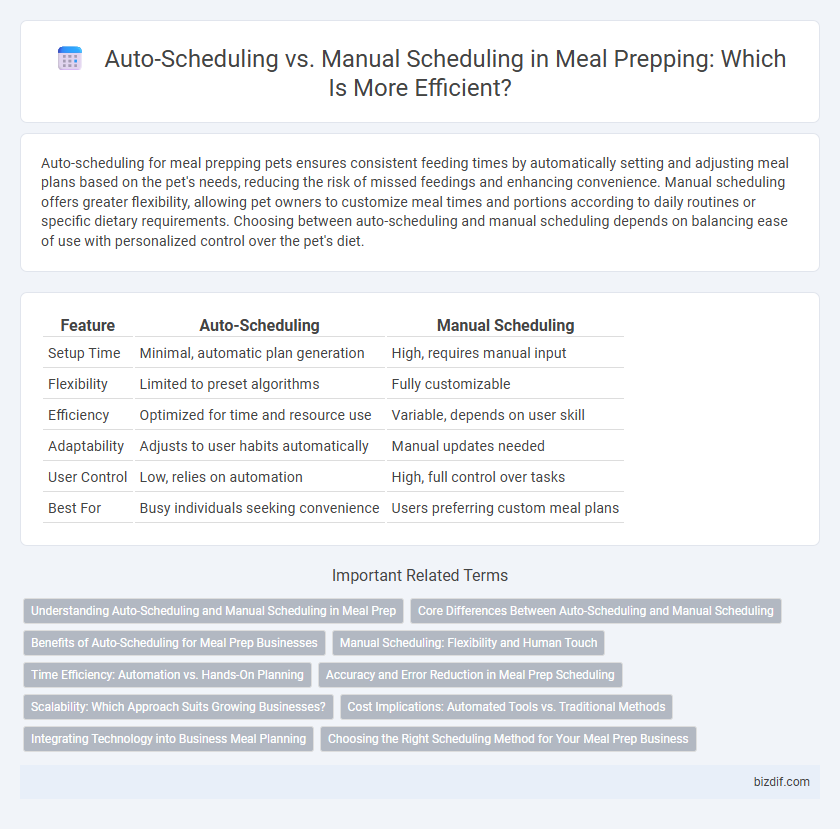Auto-scheduling for meal prepping pets ensures consistent feeding times by automatically setting and adjusting meal plans based on the pet's needs, reducing the risk of missed feedings and enhancing convenience. Manual scheduling offers greater flexibility, allowing pet owners to customize meal times and portions according to daily routines or specific dietary requirements. Choosing between auto-scheduling and manual scheduling depends on balancing ease of use with personalized control over the pet's diet.
Table of Comparison
| Feature | Auto-Scheduling | Manual Scheduling |
|---|---|---|
| Setup Time | Minimal, automatic plan generation | High, requires manual input |
| Flexibility | Limited to preset algorithms | Fully customizable |
| Efficiency | Optimized for time and resource use | Variable, depends on user skill |
| Adaptability | Adjusts to user habits automatically | Manual updates needed |
| User Control | Low, relies on automation | High, full control over tasks |
| Best For | Busy individuals seeking convenience | Users preferring custom meal plans |
Understanding Auto-Scheduling and Manual Scheduling in Meal Prep
Auto-scheduling in meal prepping leverages technology to plan meals based on dietary preferences, ingredient availability, and nutritional goals, ensuring efficiency and consistency. Manual scheduling allows users to customize meals day-by-day, offering flexibility to accommodate changing tastes or schedules. Understanding both methods helps optimize meal prep by balancing convenience with personal control.
Core Differences Between Auto-Scheduling and Manual Scheduling
Auto-scheduling in meal prepping leverages algorithms to automatically generate meal plans based on dietary preferences, nutritional goals, and ingredient availability, reducing planning time and minimizing human error. Manual scheduling requires users to individually select meals, adjust portions, and arrange preparation times, offering greater control but demanding more effort and attention to detail. The core difference lies in automation efficiency versus customized flexibility, affecting how seamlessly meal plans integrate with personal routines and nutritional needs.
Benefits of Auto-Scheduling for Meal Prep Businesses
Auto-scheduling streamlines meal prep operations by automatically organizing orders, optimizing kitchen workflows, and reducing human error, leading to increased efficiency. It enhances customer satisfaction through timely deliveries and personalized meal plans based on data-driven insights. This technology minimizes administrative workload, allowing meal prep businesses to scale effortlessly and maintain consistent quality.
Manual Scheduling: Flexibility and Human Touch
Manual scheduling in meal prepping offers unmatched flexibility by allowing individuals to tailor menus according to personal preferences, dietary restrictions, and fluctuating schedules. It provides a human touch through the ability to adjust recipes, incorporate seasonal ingredients, and respond to real-time changes in appetite or availability. This personalized control enhances meal satisfaction and supports more mindful eating habits compared to rigid auto-scheduling systems.
Time Efficiency: Automation vs. Hands-On Planning
Auto-scheduling meal prep significantly enhances time efficiency by automating ingredient selection, portion control, and cooking timelines, reducing manual input and decision fatigue. Manual scheduling requires hands-on planning that can be more flexible but often consumes more time due to detailed ingredient sorting and adjustment for personal preferences. Leveraging automated systems optimizes meal prep workflows by streamlining repetitive tasks and ensuring precise timing for ingredient readiness.
Accuracy and Error Reduction in Meal Prep Scheduling
Auto-scheduling in meal prepping significantly enhances accuracy by using algorithms to optimize ingredient quantities and cooking times, reducing human error that often occurs with manual scheduling. Manual scheduling relies heavily on individual judgment and memory, increasing the risk of inconsistent meal portions and missed steps. Implementing auto-scheduling tools streamlines the meal prep workflow, ensuring precise timing and ingredient use, which minimizes errors and improves overall efficiency.
Scalability: Which Approach Suits Growing Businesses?
Auto-scheduling enhances scalability for growing businesses by automating meal prep timelines, reducing manual errors, and optimizing resource allocation. Manual scheduling, while offering personalized control, becomes time-consuming and less efficient as order volumes increase, hindering operational growth. Integrating auto-scheduling systems enables seamless scaling by adapting to fluctuating demand and streamlining production processes.
Cost Implications: Automated Tools vs. Traditional Methods
Auto-scheduling meal prep tools significantly reduce labor costs by streamlining ingredient planning and grocery lists, minimizing food waste through precise portion control. Manual scheduling relies heavily on time-consuming calculations and trial-and-error, often leading to higher costs due to over-purchasing and inefficient use of leftovers. Automated systems' data-driven insights optimize budget allocation, making them more cost-effective than traditional meal planning methods.
Integrating Technology into Business Meal Planning
Auto-scheduling streamlines meal prepping by using algorithms to analyze dietary preferences, ingredient availability, and nutritional goals, enhancing efficiency in business meal planning. Manual scheduling allows for personalized adjustments but often consumes more time and is prone to human error. Integrating technology through auto-scheduling platforms optimizes resource management, reduces waste, and supports data-driven decisions in corporate catering services.
Choosing the Right Scheduling Method for Your Meal Prep Business
Auto-scheduling in meal prep businesses streamlines workflow by automating order processing and delivery timelines, reducing human error and saving time. Manual scheduling offers flexibility to customize orders and adjust to specific client needs, providing greater control over meal planning and inventory management. Selecting the right scheduling method depends on business size, client volume, and the need for personalized service versus efficiency.
Auto-scheduling vs Manual Scheduling Infographic

 bizdif.com
bizdif.com